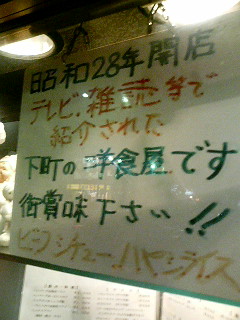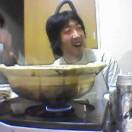Eat in Asakusa
WHEN I FIRST ARRIVED IN ASAKUSA, MONEY WAS TOO TIGHT TO MENTION. I had overextended myself in Sumatra and Singapore on the way to Japan, and I was also having trouble accessing my credit. Finding work in Tokyo hadn't proved too difficult, but getting paid was. Fortunately, I was staying in one of the cheapest places in Asakusa, with a master of austerity. The proprietor pointed out plenty of local bargains, for example the infamous beef bowl round the corner (¥280 for the regular size). There was an Ethiopian guy at the ryokan who was hardbudgeting, eating every meal at Yoshinoya, or occasionally picking up a cutpriced bento box. I might have been short of cash, but I wasn't quite that desperate yet... I supplemented my diet with Mos Burger and sushi.As Kenichi taught me, the cheapest plates cost only ¥130 (ぐらい). As time went by, my cashflow improved, and so did my dining options in Asakusa. I was soon to discover that this is a very fruitful area, fruitful and historic (and as you might expect, since Asakusa is a traditional town, traditional food is the big draw.) You can eat meals here which many modern Japanese have never tried before, or even heard of. Monja is one of the specialities of the place, up there with agemanju. There is an eel restaurant or two and this is okay with me, since eel is a superfood. Elsewhere, expect the usual tempura, sashimi, and yakitori, but cooked or prepared in idiosyncratic ways. I have eaten them all, feasted on them... thanks to the kindness of locals, but also on my own coin. On the more exotic tip, Asakusa was the place which introduced me to the culinary delights of horse, raw chicken, and whale. That said, there is nothing so gruesome reviewed in this guide. Pond loach is about as racy as it gets.
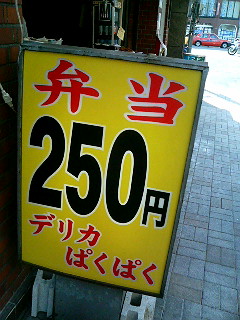
As a side note, I was recently informed of the existence of a map detailing halal food in Asakusa, Ueno and Yanaka. The map was produced by Halal Media Japan, and can be downloaded here. As we all know, Muslims have special dietary needs, and are forbidden to eat products like pork, shellfish, and so on. Thus, they might find navigating Japanese food a treacherous affair. Anyway, let's get on with it then!
Cool Cafes
CAFES ARE DIME A DOZEN IN TAITO WARD. Many of them are modest affairs, run by grandmothers, named after Midwestern states. Some of them are a bit more eclectic, a bit more eccentric, with a younger crowd. There are cat cafes, manga and Internet cafes, and even one full of freeflying parrots and owls. Alternatively, you could stick to the major chains. 23 Banchi: 墨田区吾妻橋1-23-26アネックスビル1F.(1st Floor Annex Building, 1-23-26 Azaumabashi, Sumida Ward.)
Phone: 03/5608-3831. Map: map here. Streetview: Virtual Tokyo view here!
Not really in Asakusa per se, but just across the river, at the base of the Phillipe Starck-designed Asahi Beer headquarters. Named after its address (23 ban-chi). Serves some basic pub food. Nothing special. There is a brewery upstairs, which might be more interesting. Gallery Ef: 台東区雷門2-19-18.
(2-19-18 Kaminarimon, Taito Ward.)
Phone: 03/3841-0442. Website: website here. Streetview: Virtual Tokyo view here!
With all the wars and fires and earthquakes of the past century, there aren't that many really old buildings in Tokyo. Even in authentically old neighbourhoods like Asakusa, it is hard to find anything that dates back to before 1950. Often you can feel the history, but seeing it is a different matter. Gallery ef across the road from the Kaminarimon Post Office on the banks of the Sumida River in Asakusa, Taito Ward, is about as historic as it gets in modern Japan... (For the complete guide to Gallery ef, click here.) Umezono: 台東区浅草1-31-12.
(1-31-12 Asakusa, Taito Ward.)
Phone: 03/3841-7580. Website: website here.
This is not actually a café but something even cooler, a tearoom. Opened in the first year of the Ansei Era (1854), Umezono sits next to the Umezonoin Temple, from which it gained its name. This being a tearoom, you can get tea-flavored soba noodles, but the wagashi (Japanese sweets) are the main draw. Awa Zenzai (¥720 yen), a concoction of Okayama millet and strained bean jam, is the signature dish.
Righteous Restaurants
RIGHT THEN, HERE ARE THE RESTAURANTS. Aoi Marushin: 台東区浅草1-4-4.(1-4-4 Asakusa, Taito Ward.)
Phone: 03/3841-0110. Website: website here.
This place is famous for its tempura, which it serves with thicker batter than you might be accustomed to. That said, there is supposed to be an egg-free vegetarian option. The Hana Course (華コース) goes for ¥3300, and features a range of side dishes. Chinya: 台東区浅草1-3-4.
(1-3-4 Asakusa, Taito Ward.)
Phone: 03/3841-0010. Website: website here.
Chinya is one of those historic places in Tokyo, which actually don't look that historic when you pass by them. I have never actually dined here, but this is said to be an institution. It certainly commands a strategic location, right next to Thunder Gate. Used to be a pet store for daimyou lords, has been serving sukiyaki and shabu shabu since 1890. The evocatively named Stagecoach Course costs ¥8000. Dozeu: 台東区駒形1-7-12.
(1-7-12 Komakata, Taito Ward.)
Phone: 03/3842-4001. Website: website here. Streetview: Virtual Tokyo view here!
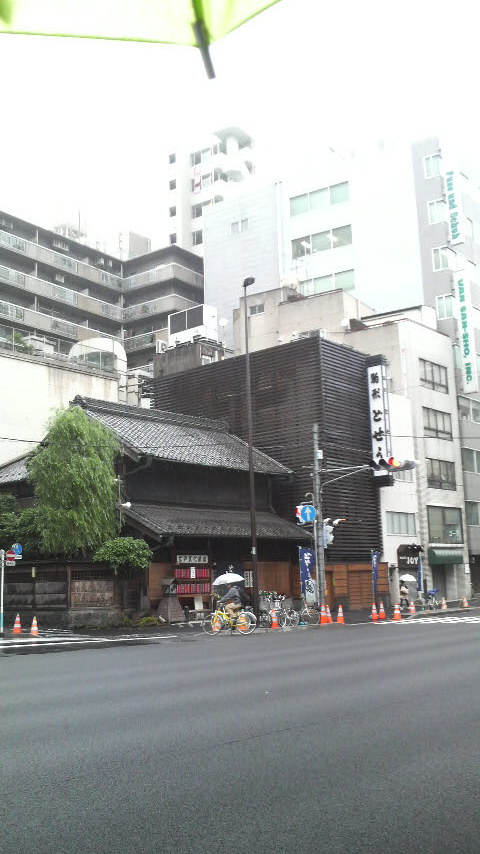
(2-1-12 Nishi-Asakusa, Taito Ward.)
Phone: 03/3845-8853. Streetview: Virtual Tokyo view here!
I am not sure if this restaurant is still open, but I enjoyed some good food here. I went there with my parents, when they made their first visit to Japan. It served as their culinary introduction to the nation... their gourmet education! If it is gone, then this review is for archival uses only! It is like a time capsule, with exquisite porcelain. We ordered some classics here, such as shin potato, sashimi, tempura with soy sauce, mountain vegetables... (For the complete review of Gaboh, click here.) Mugitoro: 台東区雷門2-2-4.
(2-2-4 Kaminarimon, Taito Ward.)
Phone: 03/3842-1066. Website: website here.
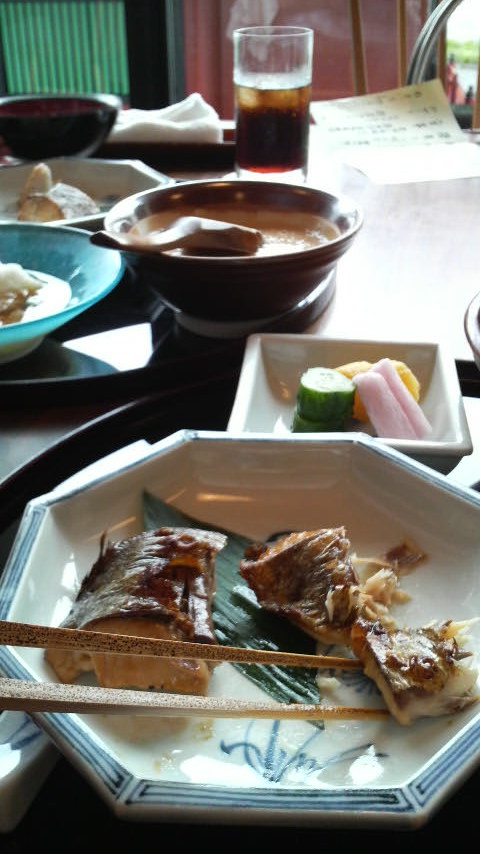
This is what I wrote on Friday, June 20, 2008, after lunching here: "For the past few weeks the way I look at Japan has been mysteriously turned on its head, twisted around, and punctured through, thanks to the influence of a little book, which I bought with a gift voucher which my telephone company gave me when I won employee of the month (again). The book is The Empire of Signs by Roland Barthes, the French semiologist, who made a trip to Tokyo in the late 1960s. After visiting Japan, Barthes concluded that emptiness was the essence of Japanese culture. In his 1970 book Barthes realized Japan as an immense reservoir of empty signs. Packages, bows of respect, the lack of a logical, ordered system for addresses of domiciles in towns and cities. The complete lack of street names. Framed by void and framing nothing (or framing a nothing), the Japanese thing shows itself as essentially form and emptiness, spotlighted on a matte black background. The funny thing is, I had already noticed that matte black background effect in Japan, but I just didn't have the words to think it, and express it, until I read Barthes..." (For the complete review of Mugitoro, and a little more about Barthes, click here.)
(1-17-9 Asakusa, Taito Ward.)
Phone: 03/3842-1919.
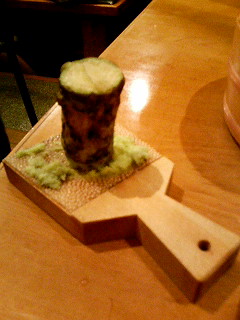
You can grate your own wasabi at this popular izakaya, which serves both Japanese and Western meals. I ate here once with Sasaki-san, one of my sponsors, after my move to Shinozaki. I was feuding with Crystal Meth at the time, although I couldn't work out why. He was pissed about something, as is sometimes his wont. It kind of put a dampener on things, spoiled the mood as you might say. Thankfully, the food and alcohol at Uosai lifted my spirits, as good food and alcohol will often do. There were bottles of sake scattered around the restaurant, standing in prominent positions, but Asahi Super Dry was my tipple of choice. I can drink that shit all night.
Youshoku Cuisine
YOUSHOKU (洋食) MEANS "WESTERN MEAL" IN JAPANESE, AND REFERS TO A PARTICULAR SUBSET OF OCCIDENTAL FOOD, PARTICULARLY THE KIND OF OCCIDENTAL FOOD WHICH BECAME POPULAR IN JAPAN DURING THE MEIJI RESTORATION. In areas in the eastern side of Tokyo, especially around Asakusa and the old "downtown" neighbourhoods, you will find plenty of restaurants advertising themselves as youshoku. These are the places where the locals (invariably old, because the neighborhoods themselves are old, gnarled as a ginkgo tree) have been eating since before the Bubble Transformation of the 1980s, and the faded decors within have plenty of stories to tell. Day after day, regular customers gather to eat the "western" meals which have been served in Japan for so long now, you could actually consider them Japanese. I am talking about those classic foreign favorites Hamburg steak, curry rice (it's been a popular dish since the Meiji Period according to one of my friends), Hayashi rice (I guess this qualifies as a genuine Japanese meal, but it has a foreign "feel"), pork cutlet katsudon sandwhiches, and so on. You could buy all this kind of fare in the convenience stores, and it is worth a try. Go to one of the old-style youshoku restaurants somewhere like Senzoku or Kuramae, and you will see this cuisine raised to the ultimate level of finesse. It is funny how the Japanese, while imitating western dishes, can make them taste even better than they are in the West. I guess it is all down to that famous Japanese "tongue for detail". Arizona Kitchen: 台東区浅草1-34-2.(1-34-2 Asakusa, Taito Ward.)
Phone: 03/3843-4932.
For the first six years of my life in Japan I lived in Uguisudani (鶯谷) in Taito Ward, near the colorful and historic heart of Asakusa. I don't live there anymore and I sometimes regret my decision to move, for perhaps alone out of the many intricate neighborhoods of Tokyo, that place has the sense of a history lived (and lived hard.) Often in my walks through Asakusa I passed a small establishment called Arizona Kitchen. From what I could gather at the time, this was a western style restaurant (Western as in American, and to be more specific, the American Wild West of the Showa imagination.) That's right, this place opened in the 24th year of Emperor Showa's reign, in the 1950s. Evidently there was a big boom in cowboy culture going on at the time, because the small garden outside the Arizona Kitchen boasted a wagon wheel, and the restaurant's name was written in authentic Wild West font... (For the complete guide to Arizona Kitchen in the old town of Asakusa in Tokyo, click here.) Kitchen Youshokuya: 台東区入谷1-5-2.
(1-5-2 Iriya, Taito Ward.)
This is what I wrote on Saturday, July 22 2006 after dining here: "Tonight I went to a local restaurant called Youshokuya, with my new friend Mrs Sasaki, and her beautiful daughter. The restaurant is on Kototoi Dori near Iriya Station, and is said to be a local institution, with nearly more than 50 years of history. That might not impress the conoisseurs of Paris or London, but Youshokuya does have a kind of genuine old world charm... okay, the wood panelling on the walls is fake but the food is real article Showa Era international Japanese! Mrs Sasaki and her daughter ordered Hayashi Rice, and as soon as their dishes arrived I felt an instant pang of urayamashii (regret) because it looked so good.
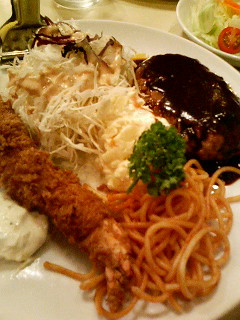
"My Hamburg steak and fried shrimp tasted great, but that Hayashi Rice was on another level completely. I wish I could have eaten it! Other items in the menu include a steak set for just under ¥3000."
